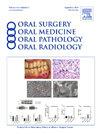Beam hardening and scatter artifact with metal objects inside and outside the field of view in cone beam computed tomography (CBCT) imaging
IF 2
3区 医学
Q2 DENTISTRY, ORAL SURGERY & MEDICINE
Oral Surgery Oral Medicine Oral Pathology Oral Radiology
Pub Date : 2025-02-04
DOI:10.1016/j.oooo.2024.11.050
引用次数: 0
Abstract
Objective
to compare the objective and subjective appearance of artifacts produced by metal objects inside and outside the limited field of view (FOV) of a common region of interest.
Study Design
Metal objects (titanium implants, zirconium implants, and zirconium crucibles) were positioned in the cadaver specimen's left maxilla and imaged using an Accuitomo 170 cone beam computed tomography (CBCT) unit with limited FOV (40 × 40 mm). Scans were obtained in standard mode for different groups (control group with no metal objects, various combinations of titanium implants, and zirconium implants/crucibles). Sixteen scans (7 with the metal object inside FOV, 7 with the metal object outside FOV, 2 controls) were obtained. Objective measurements evaluated artifacts calculating the standard deviation (SD) of grayscale values using Image J software. Two observers rated paired images for beam hardening/scatter artifacts for subjective tests. Nonparametric tests (Wilcoxon signed-rank and rank sum tests) compared grayscale values and Fleiss kappa coefficient measured intraobserver/interobserver agreement.
Results
Objective test showed no significant difference in SD of grayscale values between images with metal objects inside and outside FOV (P > .05). The SD was significantly greater for slices at the metal object level than those apical to the level of metal objects (P < .05). However, subjective comparison of the 2 image groups (metal objects inside and outside FOV) showed subtle differences in beam hardening intensity in the region immediately adjacent to the metal objects.
Conclusion
Overall, images with metal objects outside the FOV did not significantly differ in artifact compared to images with metal objects inside the FOV. However, the quality of the image immediately adjacent to the metal object can be improved by strategically avoiding the metal in the FOV.
求助全文
约1分钟内获得全文
求助全文
来源期刊

Oral Surgery Oral Medicine Oral Pathology Oral Radiology
DENTISTRY, ORAL SURGERY & MEDICINE-
CiteScore
3.80
自引率
6.90%
发文量
1217
审稿时长
2-4 weeks
期刊介绍:
Oral Surgery, Oral Medicine, Oral Pathology and Oral Radiology is required reading for anyone in the fields of oral surgery, oral medicine, oral pathology, oral radiology or advanced general practice dentistry. It is the only major dental journal that provides a practical and complete overview of the medical and surgical techniques of dental practice in four areas. Topics covered include such current issues as dental implants, treatment of HIV-infected patients, and evaluation and treatment of TMJ disorders. The official publication for nine societies, the Journal is recommended for initial purchase in the Brandon Hill study, Selected List of Books and Journals for the Small Medical Library.
 求助内容:
求助内容: 应助结果提醒方式:
应助结果提醒方式:


